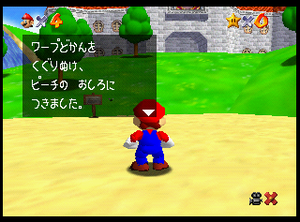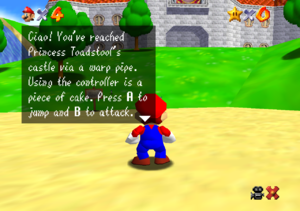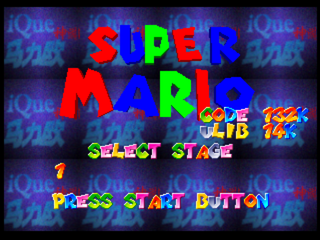Development:Super Mario 64 (Nintendo 64)
This page details development materials of Super Mario 64 (Nintendo 64).
| This page or section details content from the July 2020 Nintendo Leak. Check the July 2020 Nintendo Leak category for more pages also sourced from this material. |
On 25th July, 2020, a large amount of internal data owned by Nintendo was leaked to the public, apparently originating from either iQue-owned servers or a backup of them. This was a result of an earlier server breach in 2018, which resulted in the leaking of other assets, including but not limited to the Spaceworld 1997 and Spaceworld 1999 demos of Pokémon Gold and Silver and data for Pokémon Diamond and Pearl. The 25th July, 2020 leak included a portion of Super Mario 64's source code, featuring a large number of early and unused assets; while the code appears to specifically be for the Shindou Pak Taiou version of the game, it includes unused assets not seen in any released version, some of which seem to go as far back as 1995.
To do:
|
Contents
Sub-Pages
| Models L is truly real, 24 years and 1 month later. |
| Sprites & Textures Ya kids like billboarding? |
| Levels Where no man has plumbed before. |
| Dialogue & Text "So we surprised you, did we?" |
| Objects So much testing, such little time. |
| Stars & Object Placements Forgotten since Junuary 1996. |
| Animations Scrapped moves and early drafts, spanning all across development, yet none for Luigi. |
| Sounds An early coin, and names for unreferenced sounds. |
Internal Name Oddities
Missing Mario Segments
Mario's main model parts (excluding the head and torso) are numbered from 0-14. However, segment 11 just skips over to segment 14, implying segments 12 and 13 were removed. This oddity also exists for his LOD models and for the early backup of Mario that was found. These segments weren't deleted from Luigi, however, and are just vertex-colored variants of the head and torso parts. It's likely they were removed from Mario once the textured versions were completed. The vertex-colored torso can be seen in a 1995 B-Roll clip.
Rainbow Ride
Rainbow Ride has pretty strange internal names. Its stage folder, as well as commented-out notes in the castle's level script, repeatedly refer to the stage as "fire bubble 2." It's worth noting that Lethal Lava Land is named "Fire Bubble Land" in the Japanese version, and is frequently referred to, internally, as "fire bubble 1." In the file "star," Rainbow Ride is also called "fire_building." This suggests that the course may have been planned as a second lava stage at some point during development.
SM64 Leftovers in Mario Kart 64 Leaked Data
Unused Lighting
In depot/mk64/kimura.lzh/include/system.h, in the MK64 directory from the same leak, there is an unused alternate lighting setup for Mario and Luigi. It works differently from the final: it brightens the center of Mario and darkens the sides, making it appear as though there's a light source pointing directly at Mario's face. This is likely the lighting used in an animation in the 1995 Nintendo 64 B-Roll, which can be seen in this video. There is also early drop shadow rendering code in shade.c; this is the only bit of code in Mario Kart 64's files that is confirmed to have been intended for Super Mario 64.
//#define LIGHT_X 0 //#define LIGHT_Y 0 //#define LIGHT_Z 127
Unused Texture Font
It might be used for early versions, but it can’t be seen when it’s used. It’s colors match the final version’s colors, but some of them are not the same.
Debug Content
DEVELOP Build Map Select
A special develop build can be created by specifying it in sm64/include/project.h. When applied, a map select appears at the game's launch with two debug parameters, called CODE and ULIB, that don't exist as debugging features in the final game.
English Shindou Version
In the directory release/pvt_20031022/eng of the depot folder, which contains the full leak, the file sm.rom is a ROM image of the 1997 Shindou Pak Taiou version with English text. It doesn't seem to be a re-translation of the game, but rather just the Japanese base version compiled with the 1996 version's English text using the LOCALE=LOCALE_US compile option.
A version of Shindou with English text would eventually be released in Super Mario 3D All-Stars, although this patches in the English text real time, rather than the English text being baked into the ROM itself. For consistency, the Super Mario 3D All-Stars version also uses bits of dialog taken from Super Mario 64 DS.
| Japanese version | English version |
|---|---|

|

|

|

|







